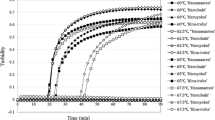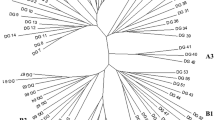Abstract
In order to study genetic variability at the DNA level in chrysanthemum (Dendranthema grandiflora Tzvelev) PstI and HindIII genomic libraries were constructed. Probes from both libraries were tested for the presence of restriction fragment length polymorphisms (RFLPs). Of the probes from the PstI library 91% appeared to hybridize to low-copy genes, while only 35% of those from the HindIII library appeared to do so. The PstI probes were used in further analyses as 79% of them showed RFLPs, whereas the HindIII low-copy number probes gave only 14% polymorphic patterns. Because of the hexaploid character of chrysanthemum, complex patterns generally consisting of 6–12 fragments were visible on a Southern blot after hybridization. To simplify the genetic analysis, locus-specific polymerase chain reaction (PCR) primers were developed that gave simple polymorphic patterns in a number of cases. The RFLP probes and primers developed will be used in future marker-assisted selection in this polyploid crop.
Similar content being viewed by others
References
Anderson NO (1987) Reclassification of the genus Chrysanthemum L. HortScience 22:313
Anderson NO, Ascher PD, Widmer RE (1992) Inbreeding depression in garden and glasshouse chrysanthemums: germination and survivorship. Euphytica 62:155–169
Cesareni G, Murray JAH (1987) Plasmid vectors carrying the replication origin of filamentous single-stranded phages. In: Setlow JK (ed) Genetic engineering: principles and methods. Plenum Press, New York, pp 135–154
Devey ME, Jermstad KD, Tauer CG, Neale DB (1991) Inheritance of RFLP loci in a loblolly pine three-generation pedigree. Theor Appl Genet 83:238–242
Dowrick GJ (1953) The chromosomes of Chrysanthemum II: garden varieties. Heredity 7:59–72
Drewlow LW, Ascher PD, Widmer RE (1973) Genetic studies of self incompatibility in the garden chrysanthemum, Chrysanthemum morifolium Ramat. Theor Appl Genet 43:1–5
Durham RE, Liou PC, Gmitter Jr, FG, Moore GA (1992) Linkage of restriction fragment length polymorphisms and isozymes in Citrus. Theor Appl Genet 84:39–48
Endo M, Inada I (1992) On the karyotypes of garden chrysanthemums, Chrysanthemum morifolium Ramat. J Jpn Soc Hortic Sci 61:413–420
Feinberg AP, Vogelstein B (1983) A technique for radiolabeling DNA restriction endonuclease fragments to high specific activity. Anal Biochem 132:6–13
Figdore SS, Kennard WC, Song KM, Slocum MK, Osborn TC (1988) Assessment of the degree of restriction fragment length polymorphism in Brassica. Theor Appl Genet 75:833–840
Gebhardt C, Ritter E, Debener T, Schachtschabel U, Walkemeier B, Uhrig H, Salamini F (1989) RFLP analysis and linkage mapping in Solanum tuberosum. Theor Appl Genet 78:65–75
Helentjaris T, Slocum M, Wright S, Schaefer A, Nienhuis J (1986) Construction of genetic linkage maps in maize and tomato using restriction fragment length polymorphisms. Theor Appl Genet 72:761–769
Kochert G, Halward T, Branch WD, Simpson CE (1991) RFLP variability in peanut (Arachis hypogaea L.) cultivars and wild species. Theor Appl Genet 81:565–570
Langton FA (1989) Inheritance in Chrysanthemum morifolium Ramat. Heredity 62:419–423
Liu YG, Mori N, Tsunewaki K (1990) Restriction fragment length polymorphism (RFLP) analysis in wheat. I. Genomic DNA library construction and RFLP analysis in common wheat. Jpn J Genet 65:367–380
Livneh O, Vardi E, Stram Y, Edelbaum O, Sela I (1992) The conversion of a RFLP assay for the determination of purity in a hybrid pepper cultivar. Euphytica 62:97–102
Nodari RO, Koinange EMK, Kelly JD, Gepts P (1992) Towards an integrated linkage map of common bean. 1. Development of genomic DNA probes and levels of restriction fragment length polymorphism. Theor Appl Genet 84:186–192
Rajapakse S, Hubbard M, Kelly JW, Abbott AG, Ballard RE (1992) Identification of rose cultivars by restriction fragment length polymorphism. Sci Hortic 52:237–245
Ritter E, Gebhardt C, Salamini F (1990) Estimation of recombination frequencies and construction of RFLP linkage maps in plants from crosses between heterozygous parents. Genetics 125:645–654
Ronald WG, Ascher PD (1975) Self incompatibility in garden Chrysanthemum: occurrence, inheritance and breeding potential. Theor Appl Genet 46:45–54
Saghai-Maroof MA, Soliman KM, Jorgensen RA, Allard RW (1984) Ribosomal DNA spacer-length polymorphisms in barley: Mendelian inheritance, chromosomal location, and population dynamics. Proc Natl Acad Sci USA 81:8014–8018
Sambrook J, Fritsch EF, Maniatis T (1989) Molecular cloning, a laboratory manual. Cold Spring Harbour Laboratory Press, Cold Spring Harbor, N.Y.
Sorrells ME (1992) Development and application of RFLPs in polyploids. Crop Sci 32:1086–1091
Stephens LC, Ascher PD, Widmer RE (1984) Interaction among sporophytic S loci in self-incompatible garden chrysanthemums. Euphytica 33:623–631
Watanabe K (1977) The control of diploidlike meiosis in polyploid taxa of Chrysanthemum (Compositae). Jpn J Genet 52:125–131
Williams JGK, Kubelik AR, Livak KJ, Rafalski JA, Tingey SV (1990) DNA polymorphisms amplified by arbitrary primers are useful as genetic markers. Nucleic Acids Res 18:6531–6535
Williams MNV, Pande N, Nair S, Mohan M, Bennett J (1991) Restriction fragment length polymorphism analysis of polymerase chain reaction products amplified from mapped loci of rice (Oryza sativa L.) genomic DNA. Theor Appl Genet 82:489–498
Wolff K, Peters-Van Rijn J (1993) Rapid detection of genetic variability in chrysanthemum (Dendranthema grandiflora Tzvelev) using random primers. Heredity 71
Wu KK, Burnquist W, Sorrells ME, Tew TL, Moore PH, Tanksley SD (1992) The detection and estimation of linkage in polyploids using single-dose restriction fragments. Theor Appl Genet 83:294–300
Zagorski JS, Ascher PD, Widmer RE (1983) Multigenic self incompatibility in hexaploid Chrysanthemum. Euphytica 32:1–7
Author information
Authors and Affiliations
Additional information
Communicated by J. W. Snape
Rights and permissions
About this article
Cite this article
Wolff, K., Peters-Van Rijn, J. & Hofstra, H. RFLP analysis in chrysanthemum. I. Probe and primer development. Theoret. Appl. Genetics 88, 472–478 (1994). https://doi.org/10.1007/BF00223663
Received:
Accepted:
Issue Date:
DOI: https://doi.org/10.1007/BF00223663




